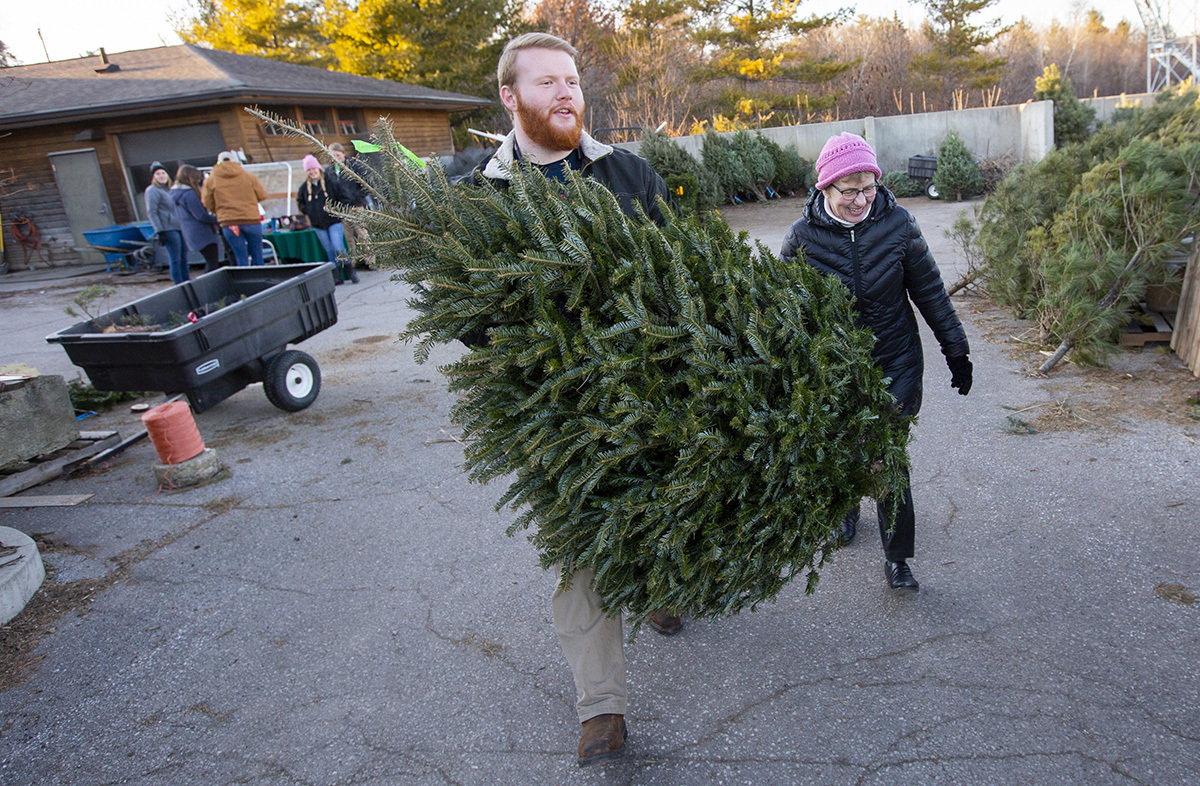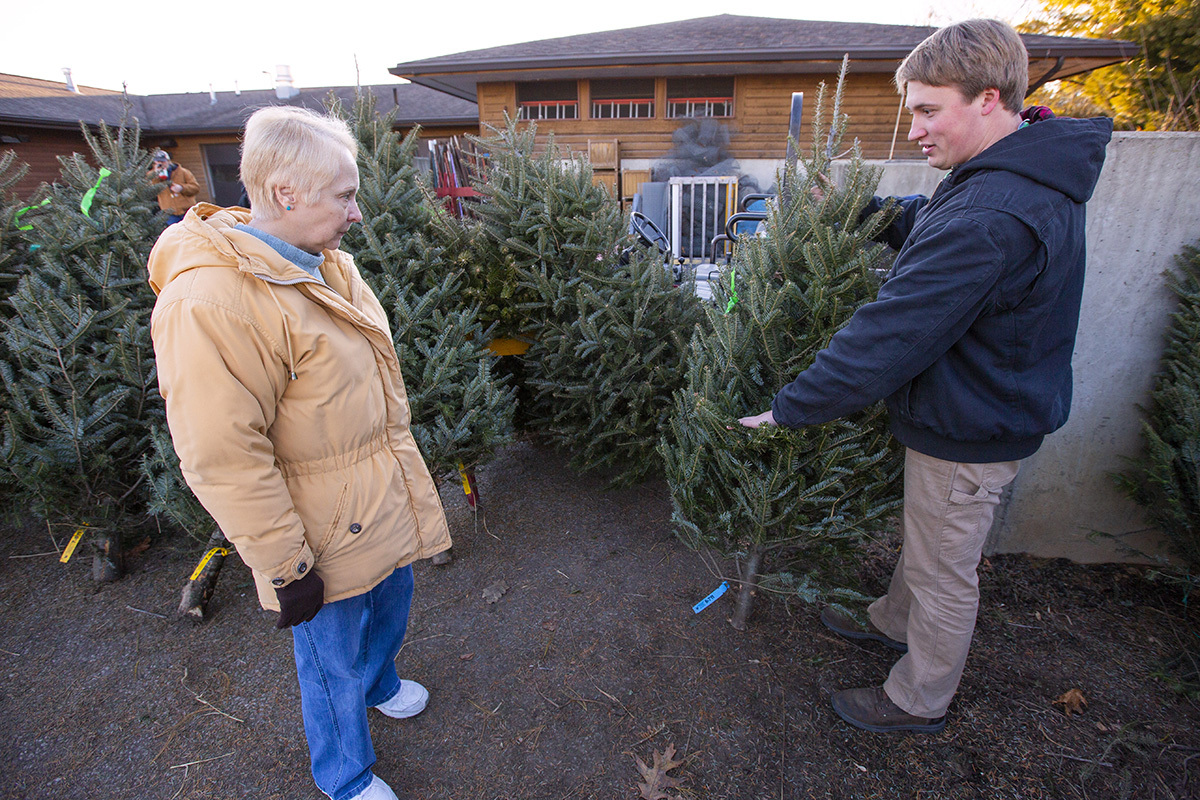Best four-legged friends

At left, Jay Newell, Greenlee School professor, shares his black Labrador, Jake, with freshman Alexis Oehlerich of Cedar Rapids, who feeds him a treat. Dogs are made available for students as a means to relieve the stress of studying for finals. Photos by Christopher Gannon.
When Jake bounded up the steps into Parks Library this week you could almost see the smile on his face. He was going to see friends who helped him through a difficult time and to return a favor.
The 3-year-old black Labrador mix is one of 35 dogs brought to the library this week by 29 owners to take part in Barks at Parks. The program runs from noon to 4 p.m. each day of study week to give students a break from final exam prep by petting and cuddling dogs.
"We adopted Jake from the Story County Animal Shelter, and they told us he had been there for three months after being found as a stray," Greenlee School professor Jay Newell said. "Student volunteers from ISU would come over to play with him and take him for car rides. When we brought the dog back into the library and he looked at the students, he just thought he was back among his people."
At least six owners who brought dogs this week are faculty or staff.
"I work with students every day, but it is usually on a very narrow range of things," Newell said. "This is an opportunity to interact with some of the same people on a different, completely pleasant, unloaded subject."
Providing help
Library organizers estimate that several hundred students take part in Barks at Parks, with some coming several times during the week. Students sit in a circle on the floor while multiple leashed dogs are led around by their owners to interact in a variety of ways.
"It is very well organized," Newell said. "The dogs can go up to students and sit with them, play, cuddle or whatever.
"I think the students like sitting together, and it is a really nice moment of community because you have the students, some professors with dogs, a lot of townspeople and it is a really pleasant moment."
Newell believes this allows students to connect with a pet, something they may miss with their own hours away at home.

Students pet a pooch during Barks at Parks.
Beth Weiser spent 38 years at Iowa State and now works at Mary Greenley Medical Center. She has brought her 10-year-old therapy Bichon Frise, Tucker, to the event for five years.
"Many times students just want to hold [Tucker], and you will see someone cuddling him to death and they will say, 'This is exactly what I needed' with tears in their eyes," she said.
Kinsey Phillips, a mental health advocate with ISU Police, spends her days providing support and resources for students, faculty and staff. She was at Barks at Parks with her 8-year-old golden retriever, Zosia, again this year.
"I never got to attend it when I was a student here, but I thought it was a great idea," Phillips said. "Being able to sit and relax with a dog has been beneficial in my own life, so I think that is really neat to witness with students."
The dogs are one of several stress-reducing activities planned throughout study week. In addition to Barks at Parks, the library offers a massage chair three days this week, a mindfulness room, coloring books, puzzles and games.
Student wellness partners with the library for its relaxation programs this week.
"For mental health, petting and visiting with dogs helps release a relaxation response, provides comfort and can reduce anxiety and loneliness," said Brian Vanderheyden, student wellness assistant director.
Accomplished pooches
The program began in spring 2014 and got its Barks at Parks title through a naming contest in 2015. In order to participate, dogs have to be Canine Good Citizen (CGC) certified through the American Kennel Club or have their Therapy Dogs International (TDI) certification. CGC is a 10-skill training program that focuses on good manners and obedience. TDI is a more comprehensive process to prepare dogs to visit nursing homes, hospitals and other institutions.
Tucker, who was named the Iowa Veterinary Medical Association's Professional Dog of the Year in 2014 and is in the Iowa Animal Hall of Fame, has made a significant impact with a wide range of people.
"We were visiting a stroke patient that could only mimic whatever you said to her, and after 15 minutes of someone saying, 'Isn't he a beautiful dog?' she responded, 'He is gorgeous,'" Weiser said. "Her husband sat down and cried."
The Cyclone Country Kennel Club of Ames, the Animal Rescue League of Iowa's Therapets program and TDI all have helped provide dogs for Barks at Parks over the years.
Lasting impact
Barks at Parks happens twice a year, but the impact on students can last far longer than the five or 10 minute interactions.
"I brought Tucker home after one event, and I took him for a walk when a car came driving by us yelling, 'Tucker, Tucker!'" Weiser said. "It was kids who were at Barks at Parks who pulled over and ended up spending another half hour with him in our backyard."

Sophomores Tori Benson, left, of Shawnee, Kansas, and Emma Williams of Bettendorf enjoy the company of Oscar the yellow Labrador during Barks at Parks.
Spring rollout planned for Workday budgeting module
A large portion of next year's university budget will be built in Workday, but it can't happen until a budgeting tool is built into Workday.
That capability will come from Workday Planning, a budget development module that will be added to the software platform that has handled Iowa State finance, payroll and human capital management functions since July 1. The project to integrate Workday Planning kicked off Nov. 5, interim associate vice president for institutional finance strategy Ellen Rasmussen said in a Dec. 5 presentation to the Professional and Scientific Council.
"We have spent a very fast month asking a lot of people a lot of questions about what they need," Rasmussen said.
Answers will help shape the customization of the planning tool, which is expected to be ready for testing by March and use campuswide in April, before final decisions are made in May and June for the budget year that begins July 1, she said. The rollout will be on a far smaller scale than the build-up to Workday's go-live this summer.
"This is for a group of budget planners at a higher level in the organization, probably at the college and divisional level," she said.
After its initial implementation, the planning module likely will expand to others. Varying levels of access will include roles limited to viewing budget plans or running reports, she said.
In its first stage, for fiscal year 2021 plans, Workday Planning will be used solely for general fund budgets, the roughly half of the university's overall $1.5 billion budget funded primarily by state appropriations and tuition. That excludes athletics, grants and contracts, ISU Dining, the residence hall system and fee-for-service units.
"The goal ultimately is to include them all. Right now, we're going for half of the pie," Rasmussen said.
Workday Planning wasn't included in the initial launch of Workday because it wasn't available yet, she said. It is based on software from Adaptive Insights, a company Workday acquired in summer 2018. Workday spent about a year assimilating the module into its enterprise platform.
Creating budget plans will be easier with the new tool both because Workday Planning is a robust and sophisticated improvement over the old and clunky system it is replacing and because it is drawing on Workday's centralized collection of updated data, Rasmussen said.
"You never have to worry about 'Do I have the right version of this?' because there is only one version," she said. "This moves us toward the future."
Suchan named university registrar
Interim university registrar Jennifer Suchan has been named to the role on a permanent basis, effective Dec. 16.

Jennifer Suchan
Suchan has extensive experience in enrollment management and student success leadership, including her role as senior associate registrar at Iowa State and service at the University of Northern Iowa (UNI) 2010-15.
"Jennifer has demonstrated outstanding leadership during two appointments as interim registrar," said associate vice president for enrollment management Laura Doering. "She is a passionate advocate for student success, and I look forward to her role on my leadership team."
Suchan will continue to provide strategic planning and direction for the office, lead the university's commencement ceremonies and maintain the confidentiality of student records. She also will help lead the implementation of Workday Student in the coming years.
"It's a great honor to serve Iowa State's students, as well as my team in the office of the registrar," Suchan said. "I look forward to working with colleagues across campus on initiatives to improve retention and graduation rates, reduce achievement gaps and use data to enhance academic success."
A native of Fort Dodge, Suchan holds a bachelor's degree in psychology and master's degree in postsecondary education-student affairs from UNI and a Ph.D. in higher education administration from Iowa State. She joined the university in 2015 after serving as assistant registrar and coordinator of military and veteran student services at UNI.
CELT staff to bring workshop to next faculty Senate meeting
The Center for Excellence in Learning and Teaching will lead an inclusive classroom workshop during the January Faculty Senate meeting. In the final meeting of the fall semester on Dec. 10, senate president Jonathan Sturm said the final hour of the Jan. 21 meeting will be dedicated to the workshop.
Last month, President Wendy Wintersteen outlined 10 actions to addresses racism and discrimination on campus in response to concerns from Students Against Racism. Among them is annual training for faculty in each academic department to create an inclusive classroom environment.
"This is not only important, but it sends a strong message that since we represent the university we value this and Iowa State values the inclusive classroom initiative," Sturm said.
Senior vice president and provost Jonathan Wickert said campus leaders -- including the president, senior vice presidents and deans -- will take part in cultural competency and cultural humility training on Jan. 9, fulfilling another of the 10 actions.
Position responsibility statements
Discussion that began at the November meeting continued on a resolution to bring faculty position responsibility statements (PRS) into compliance with the Faculty Handbook. The proposed changes remove statements beyond brief descriptions of areas of position responsibilities from faculty PRSs as well as any college or department documents related to appointment or evaluation of performance. Content in a PRS are assigned a percentage of effort to each area.
"My concern is that additional statements about mission or collegiality or teamwork are prohibited by requirements on PRSs," said Annemarie Butler, senate secretary and associate professor in philosophy and religious studies. "This does not mean we are not committed to the faculty statement of core values. We continue to be committed to all of those areas which include collegiality, diversity and inclusion, shared governance, academic freedom and others."
The resolution also calls on Sturm to convene a task force to recommend ways to foster faculty collegiality, promote faculty values and address faculty misconduct independent of a PRS.
No vote was taken and discussion will continue at a future meeting.
Term faculty report
The percentage of tenured and tenure-eligible faculty remains consistent at 73% over the past three years.
In his annual report on term faculty teaching, Wickert said the breakdown of the 1,780.2 full-time equivalent (FTE) faculty in 2019 includes 1,292 tenured or tenure-eligible and 488.2 term faculty FTEs.
Wickert said his focus is on the faculty as one group.
"We are all one faculty at this university and each faculty member contributes to our missions in various ways," he said. "We have faculty who specialize in teaching, research, extension, clinical -- but collectively, we all row in the same direction to advance the university’s missions."
New masters program
The academic affairs council proposed a master of arts in teaching in history in the Graduate College. The program, a collaboration between the history department and School of Education, would streamline the process of completing a teacher education program for students who already have a bachelor's degree and wish to teach at the secondary level. Program completion is necessary for state licensure.
Up to five students are expected to enter the program each year. The University of Iowa has a similar program, but rarely accepts ISU alumni.
Other business
- Associate provost for faculty Dawn Bratsch-Prince presented the faculty activities report, a biennial report shared last month with the state Board of Regents.
Senators unanimously approved:
- A bachelor's degree in environmental engineering in the department of civil, construction and environmental engineering. It focuses on challenges linked to land, air and water.
- A name change for the 15-credit emerging global diseases minor in the College of Agriculture and Life Sciences, to global health. The change allows the university to join the Consortium of Universities for Global Health and is expected to draw more students to the minor each year by covering more topics. 
A team approach to Title IX service
The 1972 federal law that prohibits gender-based discrimination in education programs that receive federal funding -- known commonly as Title IX -- also requires recipient schools to designate a Title IX coordinator. Margo Foreman, assistant vice president for diversity and inclusion and equal opportunity, serves in that role at Iowa State. An emerging best practice among universities is to activate deputy coordinators, and as of this fall, Iowa State has a deputy team of seven, double what it was three years ago.
Associate director of equal opportunity (EO), Adrienne Lyles, who serves as Iowa State's senior deputy Title IX coordinator, called the group the "institutional face" of Title IX, with each deputy "very visible" in their work area.
Title IX coordinating team (8)
-
Margo Foreman, equal opportunity office
University coordinator -
Adrienne Lyles, equal opportunity office
Senior deputy coordinator -
Laura Bestler, Center for Excellence in Learning and Teaching
Deputy coordinator for staff -
Dawn Bratsch-Prince, provost's office
Deputy coordinator for academic affairs -
Monica Howard-Martin, College of Veterinary Medicine student programs
Deputy coordinator for Vet Med -
Sara Kellogg, student conduct office
Deputy coordinator for student affairs -
Charles Small, athletics department
Deputy coordinator for athletics -
Judith Strand, Graduate College
Deputy coordinator for the Graduate College
"We want to have folks available locally, where they are, for people to express concerns they might have related to sex discrimination," Lyles said. "Generally, deputy Title IX coordinators serve as eyes and ears for discrimination and harassment issues."
Examples include sexual harassment, sexual violence, sexual exploitation, intimidation, stalking or disparate treatment. Discrimination based on sex frequently intersects with other kinds discrimination, she noted, and the work in the EO office covers all the protected classes in the university's discrimination policy.
Each deputy coordinator has a full-time job outside of their Title IX designation. Generally, each serves a specific population -- faculty, staff, undergraduate students, graduate students, student athletes, for example. Because of its location, the College of Veterinary Medicine has its own deputy Title IX coordinator. But Lyles said faculty, staff and students are welcome to contact any member of the team for information or assistance.
Additionally, deputy Title IX coordinators assist with education and outreach efforts such as Green Dot bystander intervention training. Last year, they helped roll out the Consent is BAE (Before Anything Else) campaign. Deputy coordinators also attend a weekly Title IX meeting, private because participants discuss specific cases, and gather several times each semester to learn more about institution-wide issues and training opportunities.
Service first
Noting that EO is a compliance office "in that we're responsible for promoting and enforcing nondiscrimination," Lyles said, "we've worked really hard at culture, at sharing our commitment to being a service unit first."
Investigations are a small piece of what the EO team does, and it doesn't do sanctions, penalties or adjudications.
When a deputy Title IX coordinator learns of alleged discrimination, that doesn't initiate a complaint or an investigation. Rather, it triggers an email to the impacted parties that includes resources and options.
"It's their choice to engage with us or not," Lyles said. "It's important to note that we are complainant-driven."
Only in extraordinary circumstances -- a clear pattern of abuse by an individual or an allegation of sexual misconduct by a faculty member against a student, for example -- would the university begin an investigation without a formal complaint.
P&S Council takes first look at FY21 salary recommendation
The Professional and Scientific Council would propose a standard performance-based P&S staff pay raise for fiscal year 2021 as high as 2% above inflation, under a recommendation discussed at its Dec. 5 meeting.
The council's plan calls for increasing the salaries of P&S staff who meet performance expectations by at least 0.5% above the rate of inflation. Raises for P&S staff exceeding performance expectations should be at least 1.5-2% above inflation, according to the council's recommendation. Inflation has hovered around 2% for the past three years, based on the federal Consumer Price Index.
"One underlying and indisputable premise is that competitive salaries are essential for the University to effectively carry out its mission on behalf of the people of Iowa," the proposed recommendation states. "A second underlying premise is that the University continues to build buildings and spend money on a wide range of new initiatives, even while P&S employees who are performing at or above expectations are losing purchasing power to inflation."
The council annually submits a salary increase recommendation and a report on compensation and benefits for university administrators to consider as they set budget priorities for the next fiscal year, which begins July 1. The council will vote on the recommendation at its Jan. 9 meeting.
The FY21 proposal also calls for offering more professional development training, identifying ways to increase revenue, improving the annual performance review model as suggested last year and maintaining the employee benefits package, "which has been for decades the one bright light in employee compensation," the council's recommendation states.
Acknowledging that its compensation recommendations appear to have little bearing on the eventual decisions, council members discussed how they could make their case more effectively. Council member Barb Wollan, a member of the compensation and benefits committee that prepared the report and recommendation, said the committee tried to stress their views more harshly than in past years.
"We were trying to make clear in the language we used that we're coming to the tipping point," she said.
Council member Tera Lawson said it's important to keep in mind that budget limitations have a real impact, though it shouldn't prevent the council from pushing the issue.
"If we don't put something forward like this, we're not representing our constituents," she said.
Council president-elect Sara Parris said she and council president Amy Ward would add the topic to the next agenda for their monthly meeting with President Wendy Wintersteen, who frequently has said competitive faculty and staff salaries are her top budget priority.
Other business
The council passed a motion in support of building on efforts to make campus a safe and welcoming community. The motion recommends reviewing all employees' engagement in diversity, equity and inclusion efforts as part of their annual performance evaluation.
Extension counties move closer to reorganization
The Structured for Success committee outlined three operating models for counties to consider and updated the timeline as ISU Extension and Outreach restructures to best educate and serve Iowans. In the next two months, county councils will select one of the models, which go into effect July 1, 2020.
The committee introduced the first two models in late August. A group of county directors put together a third model shared with the committee, which was released for feedback in October. It's an option for counties that have a county director, office manager or coordinator with similar administrative duties. All three models have a regional director funded by extension, with varied roles.
The process began in September 2018 with listening sessions with county councils and staff across the state. The structure and operations of extension services throughout the Midwest also were reviewed.
"I am very hopeful," said John Lawrence, vice president for extension and outreach. "Bringing clarity around expectations will help us, and consistency around the state is key to helping meet the needs of Iowans locally."
The models
In the first model, the regional director has supervisory responsibilities, freeing up county directors and staffs to focus on local education, engagement and programming. A regional director's skills in financial management and human resources can be spread across the counties, Lawrence said. The number of counties each regional director oversees likely will not exceed four to avoid stretching resources too thin.
"We still have some counties that are looking at what works well today rather than the longer term where they need to be," Lawrence said. "We want this to be efficient, and that is what I am asking county councils to consider."
The second model is designed for Iowa's largest counties -- those with 10 or more employees and an operating budget of at least $350,000. Single large counties or two moderate-sized counties can join together under one regional director, eliminating the need for county directors. In this model, extension covers 20% of the regional director's salary, benefits and travel, with the county or counties responsible for the rest.
The third model allows some administrative duties to remain with the county directors, who will lead day-to-day office operations and supervise county staff. The regional director, in conjunction with the extension council, oversees and supports the county director.
Councils choosing the second model must make their decision by Jan. 1, 2020, and those selecting models 1 or 3 have until Feb. 1, 2020.
The new districts formed by the restructuring will sign a memorandum of understanding (MOU) with Iowa State by June 1, 2020. It covers three years, July 1, 2020-June 30, 2023. Counties are allowed a one-time option to move from one model to another during the three-year period.
Paying for the changes
For those choosing models 1 or 3, counties will contribute a 1% service fee on top of the current shared services in the new MOUs, but the 1% fee will be waved for fiscal year 2021. County extension council budgets must be certified by March 15 and the compressed timeline proved difficult for councils during the significant transition, leading Lawrence to wave the first year of the fee.
"We are investing a little more centrally into this because I think we may have gotten spread too thin," Lawrence said. "But also we are asking counties to send us an additional 1% of the tax revenue they generate locally. I am putting about an equal amount in and we are adding four people, going from 20 to 24 regionwide directors."
Counties selecting the second model will not pay the service fee, but the 80-20 split with extension for regional director costs begins July 1.
Value to the counties
In addition to bringing some consistency to extension's county operations, Lawrence said the models will benefit county extension employees.
County staff will have more access to university human resources and equal opportunity training. Counties -- regardless of model -- will be able to offer employees ISU health and dental insurance at the merit employee rate.
"This is one more option that may work well for some counties," Lawrence said. "We are hopeful this will get better benefits across the system to help with our retention."
The agreement also brings a new way to provide feedback from both extension and the counties. Development began this month on a two-way scorecard that gives counties the ability to provide formal feedback on ISU's regional directors, program specialists and campus administration. Extension also will be able to provide its input back to the counties.
"It gives people the chance to find out how they are doing based on the agreed-upon expectations and formalizes the discussion," Lawrence said. "Before, it was always fuzzy across the state."
Degree audits pass million milestone
A small gathering this afternoon just off of central campus will celebrate a big number: For the first time, Iowa State students, faculty and staff in one calendar year have run more than a million degree audits -- the snapshot-in-time tool initially created so students, academic advisers and registrar staff could review students' academic progress toward degrees. But its use has expanded way beyond final-semester individual queries from the undergraduate and professional (veterinary medicine) students who can access it.
An undergraduate Business student requested the millionth degree audit the morning of Nov. 5. Assistant registrar Karen Terpstra anticipates that number will exceed 1.2 million when 2019 wraps up in a few weeks.
"We've been close [to a million] the last few years," she said. "We think it's a great tool, and we're excited so many people are using it."
Terpstra and colleagues Jennifer Keahna and Amber Tiarks have primary responsibility for maintaining and updating the degree audit platform. The university purchased degree audit software called uAchieve, and the team customizes it -- almost constantly -- to mirror ISU curriculum and degree requirements.
"The more custom coding we add, the more robust a degree audit can be," Tiarks said.
The key to its reliability, though, is departments regularly submitting course and program changes, they agreed.
Why the growth?
While climbing enrollments from 2007 to 2016 partially contributed to higher numbers of degree audits amid greater awareness of them, Tiarks attributed much of the growth to more interest in "batch" audits -- covering a few dozen to a few thousand students -- for comparison and research purposes.
For example, degree audits are required each semester for U.S. veteran students and NCAA student-athletes. Many accrediting organizations require degree audits of all students in an academic program as part of their review. Even the keeper of the degree audit system, the registrar's office, bumped the frequency of its routine batch audit -- which tracks students' course and scheduling changes -- from once a semester to every other week. Terpstra said the greater frequency keeps the data more current for campus queries that mine that audit for data -- for example, what courses most often are used to satisfy a specific requirement.
Also useful is the "what-if" degree audit, which lets students contemplating a different major see how their completed classes would apply to another degree program.
Bring home some holiday cheer

Senior Dylan Ferguson (left) helps Gilbert resident Jane Edwards at the Forestry Club's Christmas tree and holiday wreath sale in the Reiman Gardens parking lot. Photos by Christopher Gannon.
The ISU Forestry Club closes out its Christmas tree and holiday wreath fundraiser this weekend with sales on Friday (3-6 p.m.), Saturday (9 a.m.-5 p.m.) and Sunday (11 a.m.-5 p.m.) in the Reiman Gardens parking lot.

Senior Ben Wilson (right) helps Ames resident Karen Lawson select a tree at the sale.
The club added a new variety to its lineup, replacing the Fraser fir with the Canaan fir. Tom Isenhart, club adviser and professor of natural resource ecology and management, said the retirement of the small family-operated business that supplied their fir trees for more than two decades and a national Christmas tree shortage spurred the change.
"The new family business we are working with was sold out of Fraser firs, which was our go-to tree with the former operation," Isenhart said. "The new folks recommended we try the Canaan firs, which are growing in popularity."
The Canaan is a hybrid of the popular Fraser and balsam firs, with good needle retention, dense branches and a pyramid shape. Isenhart said the club planted Canaan firs on its tree farm west of Ames, but "the heavier soils in Iowa make them very slow growing."
Balsam fir and club-grown white pine trees also are available. Trees range from $30 to $70, and balsam fir wreaths are $20 to $30. The fundraiser proceeds support club activities, including professional development.
